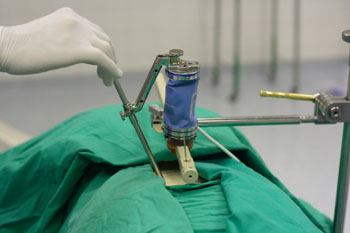Spinal Surgery
Bethesda North Hospital now offers technology that improves options for less-invasive and minimally invasive spinal surgery.
A system called SpineAssist allows surgeons to create a three-dimensional simulation of the patient's spine on a personal computer to plan exactly where to make incisions and place implants. During surgery, a robotic device guides the surgeon to the precise, pre-determined locations on the spine.
Patient Benefits
Robotic-assisted surgical technology can help treat patients suffering from chronic, debilitating back pain or limited range of motion caused by spinal deformities and degenerative conditions such as slipped vertebrae, scoliosis, and pinched nerves. Surgeons use robotics in procedures including spinal fusion, vertebroplasty and biopsies.
For patients, the increased accuracy of robotic surgery versus free-hand surgery results in:
- Precise and accurate placement of tools and implants
- Simplification of complex procedures
- Reduction of X-ray imaging needed in the operating room
Conventional Surgery vs. Robotic-Assisted Surgery

In conventional spinal surgery, large incisions must be made to allow the surgeon to see the underlying tissues and spine. In minimally invasive surgery using robotics, incisions can be smaller because the system "sees" for the surgeon, precisely guiding their tools to the proper locations. The surgeon then performs the required incisions and/or places implants. The robotic device does not cut or perform any action on the patient's body.
Proven Results
Twenty-four surgeons around the world who use SpineAssist, including one surgeon from Bethesda North, published the results of an independent study in the November 2010 issue of Spine. The study, which included cases from Bethesda North, concluded the robotic system offers enhanced performance in spinal surgery when compared to free-hand methods.